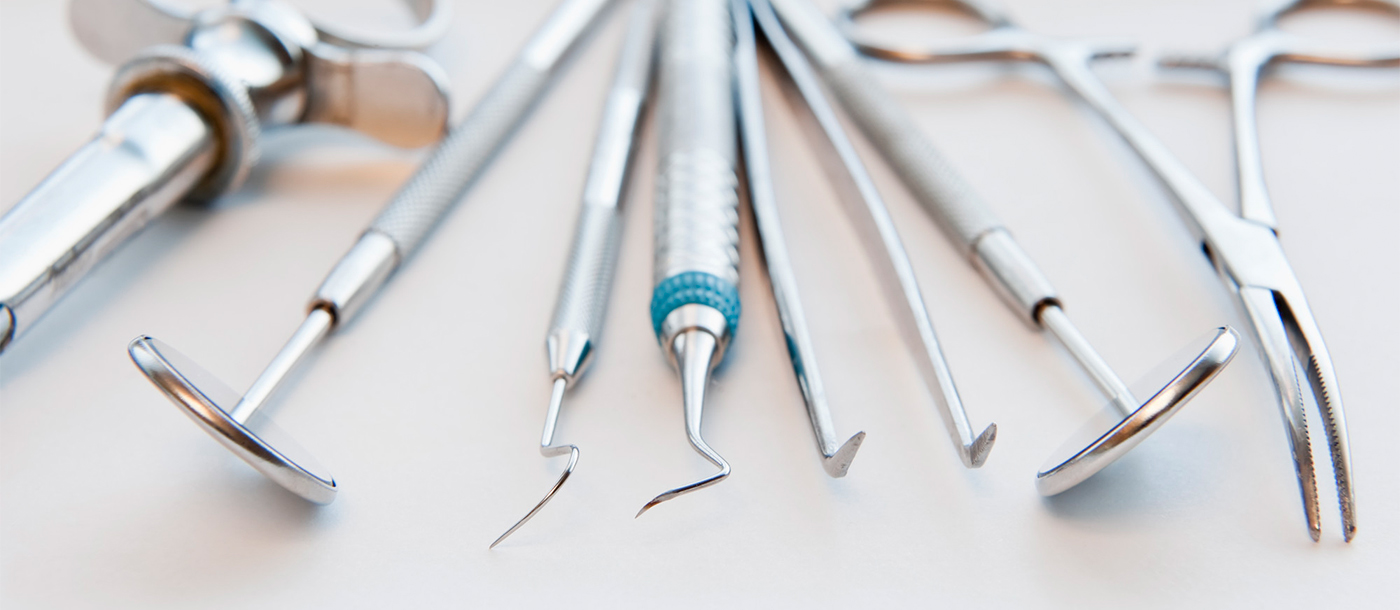M&M Insurance
Dental Insurance Info
Eight Things to Consider When Choosing Your Dental Plan
What looks like a bargain today may not be a good buy in the long run. While your out-of-pocket costs are, of course, an important part of your decision-making process when choosing a dental plan, they are not the only criteria to use when evaluating your options. Your primary focus should be to determine whether the coverage will satisfy your dental care needs. Consider the following:
1. Does The Plan Give You The Freedom To Choose?
Your own dentist or are you restricted to a panel of dentists selected by the insurance company? If you have a family dentist with whom you are satisfied, consider the effects changing dentists will have on the quality or quantity of care you receive. Because regular visits to the dentist reduce the likelihood of developing serious dental disease, it's best to have and maintain an established relationship with a dentist you trust.
2. Who Controls Treatment Decisions?
You and your dentist or the dental plan? Many plans require dentists to follow treatment plans that rely on a Least Expensive Alternative Treatment (LEAT) approach. If there are multiple treatment options for a specific condition, the plan will pay for the less expensive treatment option. If you choose a treatment option that may better suit your individual needs and your long-term oral health, you will be responsible for paying the difference in costs. It's important to know who makes the treatment decisions under your plan. These cost control measuresmay have an impact on the quality of care you'll receive.
3. Does The Plan Cover Diagnostic, Preventive And Emergency Services?
If so, to what extent? Most dental plans provide coverage for selected diagnostic services, preventive care and emergency treatment that are basic for maintaining good oral health. But the extent or frequency of the services covered by some plans may be limited. Depending upon your individual oral health needs, you may be required to pay the dentist directly for a portion of this basic care. Find out how much treatment is allowed in any given year without cost to you, and how much you will have to pay for yourself.
Every dental care plan is different. It's your responsibility to be informed about what your specific plan will cover. As a basis of comparison, the following services should be covered in full, with no deductible or patient co-payment:
- Initial Oral Examination - once per dentist
- Recall Examinations - twice per year
- Complete x-ray survey - once every three years
- Cavity-detecting bite-wing x-rays - once per year
- Prophylaxis or teeth cleaning - twice per year
- Topical Fluoride treatment - twice per year
- Sealants - for those under age 18
4. What Routine Corrective Treatment Is Covered By The Dental Plan?
What share of the costs will be yours? While preventive care lessens the risk of serious dental disease, additional treatment may be required to ensure optimal health. A broad range of treatment can be defined as routine. Most plans cover 70 percent to 80 percent of such treatment. Patients are responsible for the remaining costs. Examplesof routine care include:
- Restorative care - amalgam and composite resin fillings and stainless steel crowns on primary teeth
- Endodontics - treatment of root canals and removal of tooth nerves
- Oral Surgery - tooth removal (not including bony impaction) and minor surgical procedures such as tissue biopsy and drainage of minor oral infections.
- Periodontics - treatment of uncomplicated periodontal disease including scaling, root planning and management of acute infections or lesions
- Prosthodontics--repair and/or relining or reseating of existing dentures and bridges.
Understand what routine dental care is covered by the plan, and what percentage of the costs will come our of your pocket.
5. What Major Dental Care Is Covered By The Plan?
What percentage of these costs will you be required to pay? Since dental benefits encourage you to get preventive care, which often eliminates the need for major dental work, most plans are not generous when it comes to paying for major dental work, most plans cover less than 50 percent of the cost of major treatment. Most plans limit the benefits--both in number of procedures and dollar amount - that are covered in a given year. Be aware of these restrictions when choosing your plan and as you and your dentist develop treatment best suited for you. Major dental care includes:
- Restorative care - gold restorations and individual crowns
- Oral Surgery - removal of impacted teeth and complex oral surgery procedures
- Periodontics - treatment of complicated periodontal disease requiring surgery involving bones, underlying tissues or bone grafts.
- Orthodontics - treatment including retainers, braces and/or diagnostic materials.
- Dental Implants - either surgical placement or restoration
- Prosthodontics - fixed bridges, partial dentures and removable or fixed dentures.
6. Will The Plan Allow Referrals To Specialists?
Will my dentist and I be able to choose the specialist? Someplans limit referrals to specialists. Your dentist may be required to refer you to a limited selection of specialists who have contracted with the plan's third party. You also may be required to get permission, from the plan administrator before being referred to a specialist. If you choose a plan with these limitations, make sure qualified specialists are available in your area. Look for a plan with a broad selection of different types of specialists. If you have children, you may prefer a plan that allows a pediatric dentist to be your child's primary care dentist. Since specialized treatment is generally more costly than routine care, some plans discourage the use of specialists. While many general practitioners are qualified to perform some specialized services, complex procedures often require the skills of a dentist with special training. Discussthe options with your dentist before deciding who is best qualified to deliver treatment.
7. Can You See The Dentist When You Need To, And Schedule Appointment Times Convenient For You?
Dentists participating in closed panel or capitation plans may have select hours to see plan patients. They may schedule appointments for these patients on given days, or at specified hours of the day, restricting your access. Some dentist's fees for seeing you on weekends or during emergencies are high than those the plan allows. You may be required to pay additional costs yourself. If you select these types of plans, have a clear understanding of your dentist's policies as well as the plan's dentist-to-patient ratio. It's the best way to ensure your accessto care is not unduly restricted and that you are not surprised by higher fees the plan does not cover.
8. Will The Plan Provide Benefits To Patients Who May Also Be Covered By Another Dental Plan?
It is not unusual to be eligible for dual benefits. You may be covered under your company's plan as well as under that of your spouse'semployer. In analyzing your options, make sure to look for a plan that allows coordination of benefits. You should be entitled to either 100 percent coverage or some form of premium credit. By coordinating benefits, you can eliminate being penalized or denied coverage when the two plans have conflicting exclusions.

Getting The Best and Most From Your Plan
To take full advantage of your dental benefits plan, visit the dentist regularly and get the preventive care that will keep your mouth healthy. Follow the treatment plan you and your dentist have developed. Do your dental homework - brush and floss regularly and maintain a regular schedule of oral examinations and teeth cleanings.
Should you need treatment for particular conditions, follow the procedure for predetermination required by your plan. Find out what your insurance will cover. Feel free to discuss a payment plan with your dentist for your portion of the treatment costs.
Dental Benefits 101
Selecting an Appropriate Plan
Deciding on whether to purchase dental coverage and selecting from countless regional and national dental plans can seem like a daunting task. Whether you are considering small business, group, individual or family dental insurance, the information that follows can help guide you through the decisions. This article offers an overview of why dental insurance is important and cost effective and explains the different types of dental plans, including direct reimbursement, indemnity, preferred provider organization (PPO), dental health maintenance organization (DMHO), discount/referral. or reduced fee for services (RFFS)and point of service (POS) plans. Points to consider and questions to ask before purchasing a particular type of plan are provided. For instance, will you be able to choose your own dentist? Are services such as root canal or orthodontia covered? The article also explains the difference between fully insured and self-insured plans and defines fee for service versus managed care dental insurance. In addition, preexisting conditions, usual and customarf (UCR) and least expensive alternative treatment (LEAT) are discussed. For employers, a special section addresses participation, dependents, COBRA and retirees. Many request dental insurance free quotes and compare dental plan benefits and rates to help them select an appropriate plan to suit their needs.
Selecting an appropriate dental plan requires careful thought and research. The best plan for one company may not be the best plan for another. The processof sorting through the intricacies of different plan types can sometimes seem daunting, even to experienced benefits professionals.This article is intended to inform decision-makers about the variety of dental plans in the market, in order to ensure that high quality and affordable dental care is available to your employees. It also offers specific questions to ask before changing or selecting a new dental plan.
By Thomas D. Killam offering a dental benefits plan makes good business sense. A frequently overlooked reason for employee absences or poor work performance is dental disease or discomfort. And as an employer knows, days lost means money lost.
Moreover, in addition to promoting oral health, a quality dental benefits plan can aid in the recruitment and retention of employees. Dental benefits are consistently cited as one of the most sought after employee benefits.
Fortunately, offering a dental benefits plan to employees can be affordable. Most dental disease is preventable. With the exception of damage due to an accident, dental treatment begins with relatively low-cost diagnostic procedures, such as exams and x-rays. If decay or disease is detected, the sooner it is treated, the less expensive that treatment will be. Moreover, the dental needs of an employee group are highly predictable, For this reason, a dental benefits plan can often be self-funded. Extremes in cost and utilization (evident in many medical benefits) are rarely observed with dental statistics.
Before Selecting or Changing Your Dental Plan
Before selecting or changing a dental plan, there are some important things to consider. Fully insured dental plans are typically business arrangements between an insurance company and an employer. Most plans are designed to pay only a portion of dental expenses. However, dental plans may exclude or discourage certain treatments, such as dental sealants, which can prevent tooth decay and save money later on. Carefully read the plan and know its limitations. If a plan doesn't cover a specific procedure, this does not mean that the treatment isn't appropriate or needed.
In a self-insured plan, on the other hand, the employer generally has more flexibility to determine what dental expenses will be covered. However, many self-insured plans are administered by insurance companies under an "administrative services only" (ASO) agreement. in such cases, the insurance company's standards and procedures will usually determine what benefits are covered, even though the plan is self-insured.
Additionally, some plans do not cover conditions that existed before the employee became hired, such as missing teeth. Others may not cover dental implants, specialist referrals and other dental needs. Even when a dentist and patient agree on the appropriate treatment method for the condition, the contract provision of the dental plan may only pay a portion, or pay only for the least expensive alternative treatment (LEAT) as determined by the insurance company.
Dental plans may use the terms "usual, customary and reasonable" (UCR)to determine the portion of the dental treatment fee they will pay. UCR reimbursement levels are determined by different methods by the dental plan administrators. They may vary a great deal among plans, even when those plans operate in the same area.
The fee the insurance company determines to be "customary" may be very low compared to the area's average professional fee for the same services. The plans then generally pay a certain percentage of the UCR level. The patient may then be required to pay a greater portion of the treatment costs.
Ask The Following Questions Before Selecting A New Plan:
- Will employees retain the freedom to choose their own dentists?
- Is the type of treatment determined by the patient and the dentist?
- Does the plan pay for only the least expensive alternative treatment (LEAT)?
- To what extent does the plan cover diagnostic, preventive and emergency services?
- Will it cover preventive services such as sealants and fluoride treatments, which may save patients money in the future? Will it provide for regular dental exams and cleanings? Will it provide for full-mouth x-rays?
- What type of routine dental care is covered? Does the plan cover crowns and bridges, braces, root canals, oral surgery and treatment of periodontal diseases?
- What major dental care is covered? Does the plan cover dentures, implants or treatment for temporomandibular disorders?
- Will the plan allow for referrals to specialists? If so, will the dentist be limited to a list of specialists from which to choose?
- How does the plan provide for emergency treatment? What provisions are made for emergency care when your employee is away from home?
- If the plan requires monthly premiums, what percentage of that money goes to actual care and not to overhead or administration?
Dental health is a key factor to preserving a person'sgeneral health. While dental benefit coverage should be taken into account, it should not be the deciding factor in determining one's choice of treatment.

Getting The Best and Most From Your Plan
There are numerous models of dental plans. In general, they can be divided into two categories: fee-for-service and managed care.
Fee-for-service Dental Plans
Are typically freedom-of-choice arrangements under which a dentist is paid for each service rendered according to the fees established by the dentist.
Managed Care Dental Plans
Are cost containment systems that direct the utilization of health care by
- Restricting the type, level and frequency of treatment;
- Limiting access to care; and
- Controlling the level of reimbursement for services.
Dental Fee-for-service Plans
Direct Reimbursement
Direct Reimbursement (DR) is a self-funded dental benefits plan that reimburses patients according to dollars spent on dental care, not type of treatment received. It allows the patient complete freedom to choose any dentist. Instead of paying monthly insurance premiums, even for employees who don't use the dentist, employers pay a percentage of actual treatments received. Moreover, employers are removed from the potential responsibility of influencing treatment decisions due to plan selection or sponsorship.
The design of the DR plan is selected by the employer to fit the employer's budget, and can therefore vary accordingly. For example, one plan may reimburse 100% of the first $200 of dental expenses and 80% of the next $1,000, resulting in a total annual maximum benefit of $1,000 per covered employee. Another company may reimburse 75% of the first $1,000 of dental expenses, resulting in a total annual maximum benefit of $750 per covered employee. The totals can be individual or family maximums.
DR plans can be administered either in-house or by a third-party administrator. A DR plan may also permit employees to pay their share of their dental expenseson a before-tax basis by establishing dental "flex" accounts. Flex accounts are funded by employees with pre-tax paycheck withholding, and can be used to pay dental expensesthat are not covered by the employer. In addition to the employee's tax savings, the employer benefits because the amounts withheld from the employees' paychecks are not subject to FICA taxes. Flex accounts must comply with IRS regulations to insure that the payments qualify for pre-tax treatment.
If you are considering a Direct Reimbursement dental plan, the following questions should be addressed:
- What co-payments and annual maximum should be established?
- Will the plan be administered in-house or by a third party?
- What records will be useful to keep?
- What percentage of the cost will go toward administration? (Experience shows that between 5% and 10% of the money spent on DR will go to administration.)
- What safeguards and educational programs are in place to ensure that employees use their dental dollars wisely?
Indemnity
An indemnity plan is a fully insured or self-insured plan where an assigned payment is provided for specific services, regardless of the actual charges made by the provider. Payment may be made to enrollees or, by assignment, directly to dentists.
Usual, Customary and Reasonable (UCR) indemnity plans usually allow patients to go to the dentists of their choice. These plans pay a set percentage of the dentist's fee or the plan administrator's "reasonable" or "customary" fee limit, whichever is less. These limits are the result of a contract between the plan purchaser and the third-party payer. Although these limits are called "customary," they mayor may not accurately reflect the fees that area dentists charge. There is wide fluctuation and no regulation on how a plan determines the "customary" fee level.
If the plan purchaser is reviewing an indemnity dental plan with a UCR schedule, the following are points to consider:
- What data has been used to establish the UCR fee levels? How often are the fee levels updated?
- At what percentile is payment made? For what percentage of claims in the last year has the plan denied patients coverage for a part of their dentist's charges because of the "customary" fee screen?
- What percentage of the premiums is used for administration and not for dental care?
Table of Allowance
Table of Allowance (sometimes called "schedule of allowance") indemnity programs determine a list of covered services with an assigned dollar amount. That dollar amount represents just how much the plan will pay for those services that are covered. Most often, it does not represent the dentist's full charge for those services. The patient usually pays the difference.
If a plan calculates benefits according to a table of allowances, following:
- What is the difference between the allowed coverage and a typical dentist's fee for the listed procedures? What is the level of benefits?
- What provisions are in the plan for adjusting the table for inflation and changes in dental procedures?
- What provisions are in place for determining coverage for necessary procedures that are not included in the table?
Dental Managed Care Plans
Preferred Provider Organization
Preferred Provider Organization (PPO) programs are plans under which patients select a dentist from a network or list of providers who have agreed, by contract, to discount their fees. In PPOS that allow patients to receive treatment from a non-participating dentist, patients will be penalized with higher deductibles and co-payments. PPO scan be fully insured or self-insured. PPO sare usually less expensive than comparable indemnity plans and are regulated under the appropriate insurance statutes in the company's state of domicile and operation.
When reviewing a PPO dental plan, the plan purchaser should consider the following:
- What percentage of the premium is used for administration?
- Will the amount of the discount influence patients to change their dentist? Will the amount of the discount the dentist is required to offer affect the number of treatment options for the plan's covered individuals?
- What is the liability for the employer if the plan influences provider selection or treatment?
- What are the criteria for selection of providers for the plan? Does it have enough dentists under contract to adequately serve the group? What is the geographic distribution of patients to dentists? Does it provide for specialist referrals? Are dentists limited to referring patients to contracted specialists?
- How does the program provide for emergency treatment? What provisions are in the program for emergency care away from home?
Dental Health Maintenance Organization/Capitation Plan
Dental Health Maintenance Organization (DHMO) or Capitation Plans pay contracted dentists a fixed amount (usually on a monthly basis) per enrolled family or individual, regardless of utilization. In return, the dentists agree to provide specific types of treatment to the patient at no charge (for other treatments, a co-payment is required). Theoretically, the DHMO rewards dentists who keep patients in good health, thereby keeping costs low. DHMO models typically offer the least expensive dental plans.
If the plan purchaser is reviewing a DHMO or Capitation Plan, the following factors should be considered:
- What percentage of the premium is used for administration?
- Does the employer have access to sufficient information to determine the level and amount of treatment received by each member of the group?
- What is the utilization rate for patients in this program? What is the average waiting period for an initial appointment? What is the average period between appointments?
- What is the dentist/patient ratio for the program? What are the criteria for selecting dentists to participate in the program? What is the geographic distribution of patients to dentists?
- What is the ratio of dentists accepted into the program to those who applied to participate? How many dentists voluntarily withdrew from the program over the past two years?
- What is the capitated rate of compensation for the dentists? Is it sufficient compensation for the needs of the covered patient population? What provisions are made for dentists with unforeseen utilization or difficult cases?
- What are the benefits for patients requiring a specialist's care? How are specialists selected and compensated? Does the plan have adequate specialist participation?
- How does the program provide for emergency treatment? What provisions are in the program for emergency care away from home?
Other Types Of Dental Plans
The following two plan types also are common in the market. These plan types rarely stand alone, however, and are generally featured as aspects of other plans.
Discount/Referral Plans are arrangements in which employers direct employees to a limited number of providers who have agreed to discount their normal fees in exchange for a larger patient pool. There is no reimbursement to the patient or to the provider. A third-party marketer will package and sell a discount program for a fee, in order to cover costs and profits.
Point of Service Plans are arrangements in which patients with a managed care dental plan have the option of seeking treatment from an "out-of-network" provider. The reimbursement for the patient is usually based on a low table of allowances, with significantly reduced benefits than if the patient had selected an "in network" provider.
Who Should be Covered Under the Plan?
In addition to covering employees, most dental plans cover spousesand dependents as well. Some dental plans require that new employees work a minimum amount of time - for example, six months - before coverage begins. Although the employer generally has the right to determine which employees will be covered, if the plan is self-funded, IRS rules limit the extent to which employees may be excluded because they are part time, or have not reached a certain age or worked for a minimum period of time.
Also, most plans will terminate coverage of dependent children at a certain age: for example, at age 19 or until completion of academic studies. If the company has 20 or more employees, the federal law known as "COBRA" may require that employees or their dependents who would otherwise lose coverage be permitted to continue the coverage at their own expense for periods of up to 36 months. Even if the company has fewer than 20 employees, many states have similar laws.
Finally, many companies are encouraged to offer dental coverage for retiring employees if it was offered in the past, or as an option for retirees to purchase at their own expense if it is not currently part of an employee retirement package.
Conclusion
In the end, employers can conduct a common sense cost-benefit analysis in order to determine the best value for their dental plan dollar. There may be a trade-off when it comes to cost and quality in a plan. Also, taking into consideration the company's corporate philosophy and the employee demographics will help to make the most appropriate decision as to which plan will work best.
Once you've got an idea of the type of dental plan you're looking for, there are many resources for finding the right vendor. Your broker, benefits consultant and even your state dental society can assist you in getting a plan up-and-running at your company.

Insurance Terms
Accepted fee
The dollar amount that the attending dentist has agreed to accept as payment in full from Delta Dental and the patient. This amount is shown on the notice that accompanies payment of a claim.
Ama1gam
A common material used in fillings to repair cavities, in teeth; also known as "silver fillings." Dental amalgam is a mixture of silver, mercury and other materials.
Annual maximum
The total dollar amount that a plan will pay for dental care incurred by an individual enrollee or family (under a family plan} in a specified benefit period, typically a calendar year.
Balance billing
Dentist fees that the enrollee is billed for amounts above, the enrollees portion of the coinsurance. Delta Dental dentists agree to accept Delta Dental's contracted fees - and not to bill above that amount. Non-contracted dentists are under no obligation to limit the amount of their fees.
Basic services/basic benefits
A category of dental services in a fee-for service dental benefits contract that usually includes restorations (fillings), oral surgery (extractions), endodontics (root canals), periodontal treatment (root planing) and sealants. (This may vary by contract.) Typically, the same coinsurance percentage applies to all services grouped as basic services.
Benefits
The amounts that Delta Dental pays for dental services covered under an enrollee's contract.
Cafeteria plan
A benefit program in which an employer gives employees several benefit plans to choose from (i.e., a "menu" of benefit plans).
Capitation
Compensation paid to general dentists in closed panel dental benefit plans (such as a DHMO) for providing covered services to enrollees assigned to their office. Delta Dental's capitation-based plans require enrollees to select the network dentist from whom they are to receive all or most treatment, and the enrollee is required to pay a predefined amount ("copayment") for each procedure at the time of treatment.
Claim/claim form
A standard form that provides an itemized statement submitted by an enrollee or a dentist requesting payment of benefits for dental services provided. Delta Dental dentists always file claim forms on behalf of enrol1ees and accept payment directly from Delta Dental so that patients are not required to pay up front and wait for reimbursement. Claim forms are also used to request a pre-treatment estimate.
Closed panel plan
A type of dental plan where enrollees must visit a pre-selected or assigned network dentist in order to receive benefits.
Coinsurance
The enrollee's share, expressed as a fixed percentage, of the contract allowance. For example, a benefit that is paid at 80 percent by the plan creates a 20 percent coinsurance obligation for the enrollee. Coinsurance applies after the enrollee meets a required deductible.
Coordination of benefits (COB)
A process that carriers use to determine the order of payment and amount each carrier wiil pay when a person receives dental services that are covered by more than one benefit plan. COB ensures that no more than 100 percent of the charges for services are paid when an enroiiee has coverage under two or more benefits plans (dual coverage) - for example, a child who is covered by both parents' plans.
Copayment
A fixed dollar amount that an enrollee under certain dental plans (such as a DHMO-type plan) is required to pay at the time the service is rendered.
Contract benefit level
The percentage of the maximum contract allowance that Delta Dental pays after the deductible has been satisfied.
Contracted dentist
A dentist who has a contract with Delta Dental to participate in a Delta Dental network. The dentist agrees to accept Delta Dental's determination of fees as payment in full for services rendered to an enrollee of a Delta Dental plan. (Also may be referred to as participating dentist; network dentist or contracting dentist).
Contracted fee
The fee for each single procedure that a contracted dentist has agreed to accepted as payment in full for covered services provided to an enrollee.
Deductible
A dollar amount that each enrollee (or cumulatively a family for family coverage) must pay for certain covered services before Delta Dental begins paying benefits.
Diagnostic and preventive services
A category of dental services in a fee-for-service dental benefits contract that usually includes oral evaluations, routine cleanings, x-rays and fluoride treatments. (This may vary by contract.) Typically, the same coinsurance percentage applies to all services grouped under diagnostic and preventive services.
Dual choice
A program that allows enrollees to select one of two or more dental plans. (Also may be referred to as "dual option.")
Dual coverage
When dental treatment for an enrollee is covered by more than one dental benefits plan, such as when dental services are provided to a child that is covered by both parents' benefit plans.
Effective date
The date a dental benefits contract begins. Effective date may also be used to describe the date that benefits begin for a plan enrollee.
Eligible enrollee
An enrollee who has met the eligibility requirements under a Delta Dental plan.
Eligibility
The circumstances or conditions that define who and when a person may qualify to enroll in a plan and/or a specific category of covered services. These circumstances or conditions may include length of employment, job status, length of time an enrollee has been covered under the plan, dependency, child and student age limits, etc.
Fee-For-Service
Compensation paid to dentists based on an amount per service. A Fee-For-Service plan generally permits enrollees to freely select a network or non-contracted dentist to provide the service. Delta Dental Premier® and Delta Dental PPOSM are fee-for-service plans.
Freedom of choice
A plan feature that permits an enrollee to visit any licensed dentist and receive benefits for covered services.
Health maintenance organization (HMO)
An entity that is authorized to issue a benefit plan in which enrollees receive all or most treatment through a pre-selected or pre-assigned dental office. The dentist receives a monthly capitation payment for each patient that selects or is, assigned to that office no matter how many services that patient receives. (See "Capitation")
Indemnity/indemnity plan
(See fee-for-service)
In-Network/Out-of-Network
Services provided in a plan either by a contracted dentist or noncontracted dentist. In-network dentists have agreed to participate in a plan and to provide treatment according to certain administrative guidelines and to accept their contracted fee as payment in full. Different plans are each served by distinct dentist networks. Delta Dental PPO dentists are in-network dentists for Delta Dental PPO plans. Delta Dental Premier dentists are in-network for Delta Dental Premier plans. DeltaCare USA® dentists are in-network for DeltaCare USA plans. Non-Delta Dental dentists are out-of-network for all of these plans.
Lifetime maximum
The cumulative dollar amount that a plan will pay for dental care incurred by an individual enrollee or family (under a family plan) for the life of the enrollee or the plan. Lifetime maximums usually apply to specific services sucn as orthodontic treatment.
Limitations and exclusions
Dental plans typically do not cover every dental procedure. Each plan contains a list of conditions or circumstances that limit or exclude services from coverage. Limitations may be related to time or frequency (the number of procedures permitted during a stated period) - for example, no more than two cleanings in twelve months or one cleaning every six months. Exclusions are those dental services not covered by the plan.
Major services
A category of dental services in a fee-for-service dental benefits contract that usually includes crowns, dentures, implants and oral surgery. (This may vary by contract.) Typically, the same coinsurance percentage applies to all services grouped under major services.
Network
A panel of dentists that contractually agree to provide treatment according to administrative guidelines for a certain plan, including limits to the fees they will accept as payment in full.
Open access
A plan feature that allows enrollees to visit the dentists of their choice (freedom of choice). Also sometimes used to describe an enrollee's ability to seek treatment from a specialist without first obtaining a referral from his/her primary care provider.
Open enrollment
A period (usually a two-week or one-month period during the year) when qualified individuals (eligible employees) can enroll in or change their choice of coverage in group benefit plans.
Out-of-pocket costs
Any amount the enrollee is responsible for paying, such as coinsurance or copayments, deductibles, and costs above the annual maximum.
Participating dentist
See Contracted dentist
Patient's share
The portion of a dentist's fee that an enrollee must pay for covered services, including coinsurance, copayment, any remaining deductible, any amount over plan maximums, and/or any services the plan does not cover.
Preauthorization
A requirement that recommended treatment must first be approved by the plan before the treatment is rendered in order for the plan to pay benefits for those services.
Preferred provider organization (PPO) plan
A reduced fee-for-service plan that allows enrollees to visit any dentist but encourages them to visit PPO network dentist to minimize out-of-pocket expenses. Enrollees usually pay less when visiting a PPO dentist.
Prepaid plan
A term used to describe a benefits, plan in which a carrier pays (prepays) network dentists a capitated amount for each patient enrolled in (assigned to) his/her office. Enrollees receive all or most treatment through the dental offices where they are enrolled, and the enrollee pays a predefined copayment for each procedure.
Primary enrollee
An individual (commonly, an employee or member of an association). who meets the eligibility requirements for enrollment in a dental plan. Family members of a primary enrollee are called dependents.
Preventive services
See "Diagnostic and preventive services."
Pre-treatment estimate
Delta Dental's written estimate of benefits available as of a specific date, given to an enrollee or treating dentist in advance of proposed treatment. Pre-treatment estimates are subject to policy limitations and the patient's eligibility at the time the services are rendered. (May also be referred to as pre-determination.)
Provider
Any licensed dentist who performs dental health services for an enrollee. This includes general dentists and dental specialists (endodontists, periodontists, orthodontists, pediatric dentists, oral surgeons and prosthodontists).
Submitted fee
The amount that the dentist bills and is entered on a claim as the charge for a specific procedure.
Table program
A dental plan where benefits are. based on a specific table or schedule of allowances or fees. The table lists the maximum amount that a plan will pay for each procedure. Enrollees are responsible for paying any difference between the amount the plan pays and the amount the dentist charges for the service. For non-contracted dentists, there is no limit as to the amount the dentist may charge.
Usual fee
The amount commonly charged for a particular service by a provider.
Waiting period
A stated period of time that a person must be enrolled in a plan before being eligible for benefits or for a specific category of benefits.

Dental Terms
Teeth
Bicuspids/premolars
The teeth with two rounded points located between the eye teeth (cuspids) and the molars.
Centrals/laterals
The four front teeth.
Cusp
The pointed or rounded part of a tooth's biting surface.
Cuspids
The teeth near the front of the mouth that come to a single point. Sometimes called the "eye teeth" or "canines."
Molars
Teeth with a broad chewing surface for grinding food, located in the back of the mouth.
Endodontics
Treatment of the root and nerve of the tooth.
Periapical
The area surrounding the end of a tooth root.
Post and core
An anchor placed in the tooth root following a root canal to strengthen the tooth and help hold a crown (cap) in place.
Pulp
The blood vessels and nerve tissue inside a tooth.
Root canal treatment
The removal of the pulp tissue of a tooth due to decay or injury.
Orthodontics
Straightening or moving misaligned teeth and/or jaws with braces and/or surgery.
Malocclusion
Incorrect position of biting or chewing surfaces of the upper and lower teeth.
Retainer
A device used to stabilize teeth following orthodontic treatment.
Pedodontics
The dental specialty devoted to the treatment of women.
Nursing bottle syndrome
Severe decay in baby teeth due to sleeping with a bottle of milk or juice. The drink's natural sugars combine with bacteria in the mouth to produce acid that decays teeth.
Pedodontist/pediatric dentist
A specialist who treats children from birth through adolescence.
Sealant
A thin plastic material used to cover the biting surface of a child's tooth to prevent tooth decay.
Periodontics
Treatment of gums, tissue and bone that supports the teeth.
Gingivitis
An inflammation of the gums surrounding the teeth caused by a buildup of plaque or food particles.
Periodontitis/gum disease
Chronic inflammation and destruction of supporting bone and tissue membrane around the roots of teeth.
Root planing
A treatment of periodontal disease that involves scraping the roots of a tooth to remove bacteria and tartar.
Prosthodontics
Replacement of missing teeth with artificial materials, such as a bridge of denture.
Bridges
Nonremovable tooth replacements attached to adjoining natural teeth when one or a few teeth are missing.
Dentures
Removable artificial teeth in a plastic base that rests directly on the gums. A denture may be complete or partial depending on the number of missing natural teeth.
Implant
A support for a bridge or denture that has been surgically placed into bone.
Overdenture
A prosthetic device supported by implants or the roots of at least two natural teeth to provide better stability for the denture.
Pontic
The portion of a dental bridge that replaces missing teeth.
Restorations
Replacement of missing or damaged tooth structure with artificial materials.
Amalgam
A silver filling. Used for more than a century, amalgam fillings are proven to be safe, cost-effective and durable.
Cast restoration
A procedure that uses a model of the tooth (an impression) to make a casting which replaces missing parts. Example: a crown.
Crown/jacket/cap
The artificial covering of a tooth with metal, porcelain or porcelain fused to metal. Crowns cover teeth weakened by decay or severely damaged or chipped.
Inlay
A solid filling cast to fit the missing portion of the tooth and cemented into place. An onlay covers one or more tooth cusps.
Resin/composite
Tooth-colored filling material used primarily for front teeth. Although cosmetically superior, it is generally less durable than other materials.

Other Dental Terms
Attrition
The normal wearing down of the surface of a tooth from chewing.
Bleaching
A technique that lightens the color of heavily stained teeth.
Bonding
A technique to bind a filling or filling material to a tooth. Bonding materials may be used to repair chipped, cracked, misshapen or discolored teeth or to fill in a gap between teeth.
Bruxism
Involuntary clenching or grinding of the teeth.
Caries
Tooth decay, which leads to a cavity.
Facing
A plastic or porcelain surface placed on the front of a tooth or crown for a natural appearance.
Impacted tooth
A tooth beneath the gum tissue that lies against another tooth, under bone or soft tissue, which is unlikely to grow out on its own.
Laminate veneer
A thin plastic or porcelain shell applied to the front of a tooth to restore, strengthen or improve its appearance.
Plaque
A bacteria-containing substance that collects on the surface of teeth. Plaque can cause decay and gum irritation when it is not removed by daily brushing and flossing.
Prophylaxis
A professional cleaning to remove plaque, calculus (mineralized plaque) and stains to help prevent dental disease.
About Dental Insurance
Dental insurance helps protect you from unexpected dental expenses and makes it easier to afford to keep up the regular checkups, cleanings and other preventive treatments you need to keep your mouth healthy.
Like medical insurance, dental insurance provides benefits for a specific rate or premium. Different plan designs offer various levels of coverage and different choices in which dentists you can visit.
The major differences between dental insurance plans:
- The choice of dentists
- Your out-of-pocket costs
- How dental treatments are paid
Most types of insurance, like a dental PPO, DPO, DHMO or prepaid plan, rely on a network of dentists. These participating dentists agree to perform services for patients at pre-determined rates and usually will submit claims for you. You'll usually pay less when you visit a network.
Most(but not all) traditional indemnity or fee-for-service insurance products do not provide a net work feature, so you may have to pay for services up front, file your own claims, and wait for the insurance company to reimburse you. However, there are advantages such as having the freedom to visit the dentist of your choice.

How to Shop For Dental Plans
The Basics
Getting quality, affordable dental care can be difficult. It's important to decide what matters most to you in making the best decision for you and your family.
Start by collecting old statements from your dentist or insurance company to get an idea of how much you spend on dental care each year. Think about additional expenses that might come up this next year - do you have a child who needs braces? Ask your dentist for cost estimates. Use this information as you answer the following questions, which will help you compare dental plan options:
9-Point Checklist
1. What Is The Monthly Premium?
The premium cost is just one part of the total costs of your dental care. This amount varies depending upon the level of benefits provided by the plan. For example, a plan with a low deductible (e.g., $50) and a high annual maximum (e.g., over $1,500) would likely have a higher premium than another plan with a high
2. Which Dentists participate in the plans network in my area?
Consider how important choice of dentist is to you. It may be worth it to pay more in premium, co insurance, and other costs if it means you can keep your current dentist. If you're choosing a new dentist, be sure there are conveniently located dentists in the network who offer the services and specialties your need.
3. Is My Dentist In The Network?
If your dentist is not in the plan's network, are you comfortable changing dentists? You will probably pay more out of pocket if you choose a dentist who does not participate in a plan's network.
4. How Much Will I Have To Pay If I See A Dentist Outside The Network?
Some plans do not cover any charges from a dentist outside the network. Some will cover emergency care and others may cover a portion of the charges, but typically less than if you chose an in-network dentist
5. Is There A Deductible And How Does It Work?
If your plan has a deductible, you usually have to pay the deductible amount towards this care before the dental plan pays anything. After that, the dental plan will pay the percentage of the cost specified in your plan benefits for different services (for example, 80% for routine cleanings).
Some plans exclude certain services from applying towards the deductible, such as routine exams and cleanings. This means the plan would pay its share, even if you haven't met your deductible.
Estimate your portion of the payment for any services your family needs (e.g., one crown a year, two fillings, etc.} in a year for each plan you are considering, factoring in the different deductibles offered by each plan.
6. Is There A Maximum Amount Of Coverage Allowed Each Year?
The maximum amount is the total amount of dollars the dental plan will payout for services you or your family receives. There can be different maximums: an annual maximum for most services, and a lifetime maximum which often applies-for services such as orthodontia (e.g., braces).
Compare your estimated dental expenses to the plan maximums and consider the other costs: premium, deductibles, and coinsurance - how much will you pay combined?
7. What Is The Level Of Coverage?
Compare the copayment amounts or coinsurance percentages for each plan against the kinds of services you think you might need.
8. Are There Waiting Periods For Certain Procedures?
Some plans have a waiting period for certain types of dental treatments. For example, you might have to be covered for six months before you are eligible for orthodontic coverage. Think about the services that you may need this year - are you comfortable with having to wait for treatment?
9. Which Procedures Are Covered?
Review the limitations and exclusions of each plan to make sure the procedures you might need are covered. If not, consider the out-of-pocket cost when comparing against a plan that does cover such treatments.
In general, it's easiest when you can prioritize what matters to you most: affordability, breadth of coverage, or choice of dentist. Knowing this will help you determine the best benefit plan for your needs.


